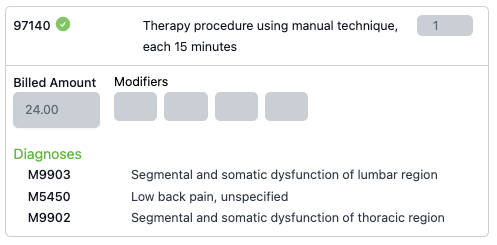A Chiropractor’s Guide to Proper Billing - Part 2: Massage Therapy (97124) vs. Manual Therapy (97140)
As a chiropractor, ensuring that your billing and documentation for therapeutic services are accurate is vital for both compliance and reimbursement. Two key CPT codes that are commonly used in chiropractic practices—97124 for massage therapy and 97140 for manual therapy—require careful attention to detail. This guide will explain the differences between these two codes, help you understand their billing requirements, and offer tips on proper documentation to optimize your reimbursement.
What Are CPT Codes 97124 and 97140?
The correct use of CPT codes is essential to ensure proper reimbursement for services rendered. For chiropractic practices, the two codes most often applied for soft tissue procedures are the following.
| CPT Code 97124 - Massage Therapy | CPT Code 97140 - Manual Therapy | |
|---|---|---|
| Description | Massage therapy that focuses on increasing circulation and muscle relaxation through techniques like stroking, compression, or percussion. | Manual therapy focusing on musculoskeletal impairments, including joint mobilizations, manual traction, or lymphatic drainage. |
| Time-Based | Billed in 15-minute increments of direct patient contact. | Billed in 15-minute increments of direct patient contact. |
| Applications | Muscle tension, spasticity, muscle contractures, impaired circulation, tissue manipulation techniques like effleurage or tapotement. | Myofascial pain syndrome, fibromyalgia, joint contractures, tissue scarring, manual manipulation, and mobilization techniques. |
Though both codes are used for soft tissue treatments, they have specific documentation and billing requirements that must be followed to ensure reimbursement.
Check out this informative video from Dr. Evan Gwilliam of Practicsync, which breaks down these two codes.
Key Similarities Between 97124 and 97140
While 97124 and 97140 are distinct procedures, they share several important characteristics that you should be aware of:
Time-Based Billing: Both codes are billed in 15-minute increments, adhering to the Medicare "8-minute rule." For billing to be accurate, a minimum of 8 minutes must be completed to bill one unit. For multiple units, the total time must reflect the required duration.
One-on-One Contact: Both codes require direct patient contact with a licensed provider, though some states and payers may allow delegation to unlicensed individuals under specific conditions.
Documentation Requirements: Clear, detailed documentation is essential for both codes. You must specify the areas treated, the techniques used, and the patient’s progress toward functional goals. Be sure to document any progress or lack of progress during each session, especially for ongoing procedures.
Use of Modifier GP: For outpatient therapy services, some payers (e.g., CMS and UHC) may require the addition of modifier GP to indicate that these procedures are part of a rehabilitation plan.
Differences Between CPT Codes 97124 and 97140
The main difference between these two codes lies in the desired therapeutic outcomes.
| CPT Code 97124 - Massage Therapy | CPT Code 97140 - Manual Therapy | |
|---|---|---|
| Primary Goal | Increase circulation and promote muscle relaxation | Improve range of motion and functional movement |
| Typical Techniques | Stroking, compression, percussion (effleurage, petrissage, tapotement) | Joint mobilization, manual lymphatic drainage, and manual traction |
| Common Indications | Muscle tension or spasticity – Muscle contractures limiting ROM – Abnormal tissue adherence – Impaired circulation due to paralysis | Myofascial pain syndrome (trigger points) – Fibromyalgia, myositis – Edema/joint swelling – Scarring or contractures |
| Documentation Tips | Use terms like “stroking,” “compression,” or “percussion” to match the code clearly | Use terms like “mobilization,” “manual traction,” or “lymphatic drainage” to justify the code |
| Code Selection Note | Based on relaxation-focused treatment using massage techniques | Based on functional improvement through manipulation or mobilization |
Conclusion
While there is certainly overlap between the indications for these two codes, the selection of the code listed on the claim is based on the documentation of the procedure and the outcomes. The codes are not interchangeable simply to increase the chances of payment; rather, they should be based on the documentation.
When deciding which code is more appropriate, ensure the documentation includes objective findings that align with the official code description and goals that focus on the parameters outlined by the code and the payer and CPT guidelines above. If these considerations are all met, services coded with 97124 or 97140 will be defensible should they ever be challenged.
For even greater efficiency in managing your billing and documentation, consider using ChiroUp’s EHR to streamline the process - ensuring your billing and documentation are as smooth and compliant as possible. Schedule a quick demo here!
Missed Part 1 on billing codes 97110 and 97530? Catch up here!
Dr. Gwilliam is the Senior Vice President of Practisync, which helps practices improve efficiency and collect more through outsourced expert billing services. If you would like to see if Practisync could be a good fit, reach out to Dr. Gwilliam at evan.gwilliam@practisync.com or visit Practisync.com for more details.
CPT codes and their descriptions are copyrighted by the American Medical Association (2025). All rights reserved. The AMA assumes no liability for data contained or not contained herein.



